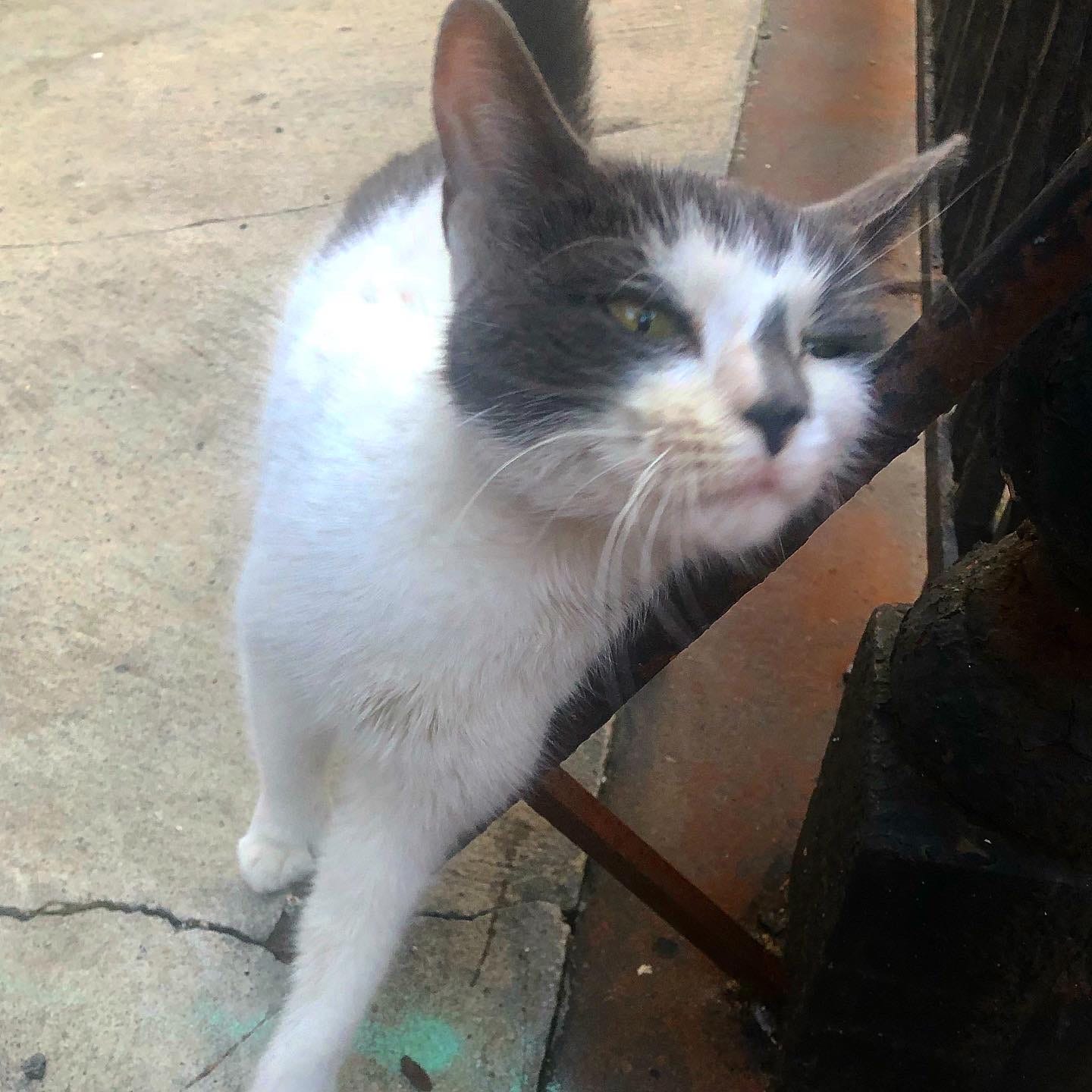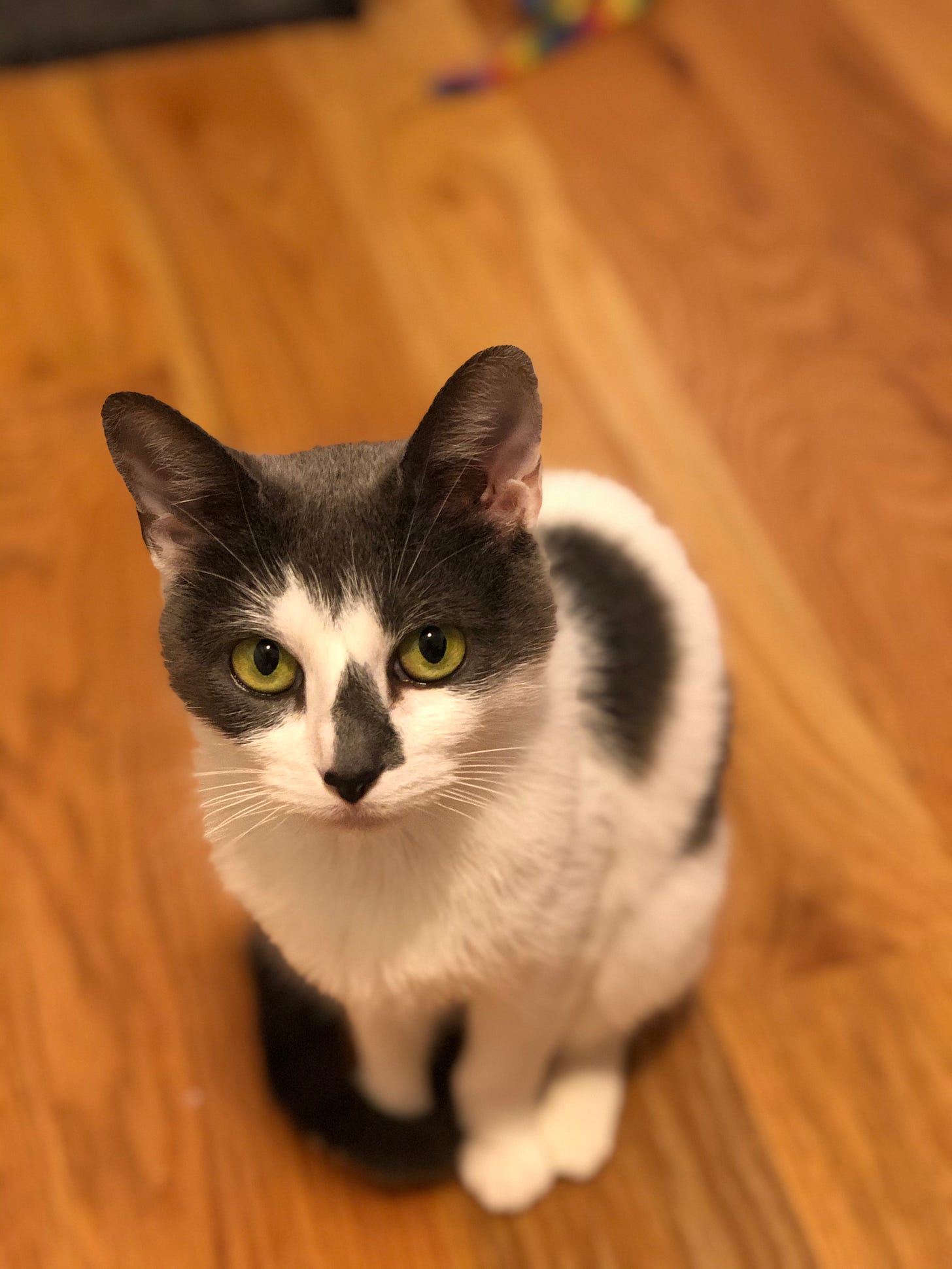Florence
In early April, I was walking through my neighborhood and spotted a skeletally thin adolescent cat. Besides being able to see her ribs and hip bones, the skin on her hind legs was furless, raw, and scabbed.
A sad fact I’ve learned in my short year-and-a-half of rescue experience is that there are many animals that you can’t do much for beyond TNR (trap/neuter/return) and, if you’re lucky, a wellness check with a vet, though the latter can be cost prohibitive. As kittens get older, they become more feral and it’s typically not worth the effort to socialize and home them after a certain age, which can be as early as seven or eight weeks. There comes a point where a cat born outside becomes a wild animal; you might as well be trying to socialize a raccoon.
From the look of her, I guessed this cat was between seven months and a year, which is to say well past the age where there’s much chance of her adapting to an indoor life and being around people. But something about her made me pause. We locked eyes and she walked right up to me, meowing to be pet. Her circumstances became clearer: She was not a feral, but had been dumped by her owners — something that happens with unfortunate regularity here in Brooklyn and probably where you live, too. Maybe she was a bodega or house cat thrown out because of whatever was happening on her back legs. Maybe it was something completely different. I’ll never know what exactly happened to her before she met me.

I debated what to do for a couple minutes. I asked some neighbors nearby if they thought she belonged to anyone. They said they’d seen her around for a little while and that she was always dirty and hunting for food. I made an impulse decision and shoved her in a tote bag that I’d been using to deliver groceries. She didn’t seem to love it, TBH.
I arrived home to my partner, horrified that I’ve hit the point of possibly kidnapping cats off the street but open to letting her hang out in the (heated) basement for at least a few days while we figured out what to do next. In an experience that left both me and the cat traumatized and covered in cat blood (her scabs opened), cat feces (she panicked and pooped herself), and cat piss (you get it by now), I managed to wash most the dirt from her fur. She was still a bag of bones but at least she was clean. What became clear, as things settled down and I consulted with fellow rescuers, is that she was not meant to be outside and had she been left behind, she likely would have died. She was immediately friendly and affectionate. I named her Florence Pugh.
Florence, as I repeatedly reassured my partner, was going to be an easy project. After we got her to the vet and brought her weight up (not a challenge as she inhaled can after can of wet food), we could get her spayed and then adopted. I predicted we’d have her for two weeks, a month tops.
But as it goes with animals, nothing is predictable.
After a couple days with us, I noticed a bald patch between her jabby little shoulder blades. After doing my own research, I determined it was ringworm, which it turns out is not actually a worm, but a fungus. I took her to the vet where she panic-pooped again. The vet thought it was allergies, but did a test anyway and gave me some topical cream. A couple days later, the ringworm test came back negative (rejoice!), but over the next couple weeks she began to lose fur across her entire back. It was itchy and she was uncomfortable, barely moving the entire day so as to not irritate her raw, scratched skin. I decided to take her to a different, albeit more expensive vet (the one we bring our own cats, too) who was suspect of the allergies diagnosis. Still, she thought we should continue with pricey allergy cat food for the time being, but also sent a skin cell sample to specialized lab to see if it actually had been ringworm all along. The test cost nearly $300, but revealed what a typical ringworm test could not: She did have it and, even better, a couple days later I found a ring-shaped rash on my own hip. She’d passed it to me.
Ringworm (sorry if you hoped I was done on the subject) isn’t as big of a deal as it’s made out to be. There are easy treatments for it. The challenge, however, is that it’s incredibly contagious and hard to get rid of. The room upstairs that Florence now occupied required constant disinfecting. She had to take an oral medication that she hated to the point that she’d shoot out of my arms like a dart when I gave it to her. And her problems didn’t stop there.
Because of her health status, multiple veterinarians advised that we hold off on spaying until everything had been cleared up. Florence began cycling in and out of heat, which turned her into one of the most annoying cats I’ve ever encountered. Women, ya know?? She wailed constantly. She peed on everything, ruining two keyboards and countless other items. Once we cleaned it up, she’d start over and pee on everything all over again.
In that time, I would occasionally resent her and regret my decision to scoop her off the street knowing nothing of her medical history. She was costing me money that I barely had. I referred to her, mostly with affection, as the most expensive piece of garbage I’ve ever picked up. My partner had to remind me of a sort-of mantra that I’ve developed while rescuing and fostering: “You will never get to experience the best of this animal, but because of your work, their adopter will.”
Finally, at the end of July, Florence was ringworm-free and so, thankfully, was I. The challenges weren’t over but were coming to a close. Because of COVID-19, many animal spay services were shut down, leaving rescuers with an abundance of intact animals and very few places to get them spayed and neutered. At a private vet, it was going to cost $400-700. But I’m insanely grateful and lucky to have access to a rescue community — a fellow rescuer took pity on me and gave Florence one of the highly coveted appointments with the Toby Project, an organization that provides affordable, sometimes free spay and neuter services for animals throughout the city. Florence had her surgery this past Saturday. The vet discovered she had an ovarian cyst and a uterine infection, but because a spay is a full hysterectomy, she no longer has these issues.
In the days since she’s been back, Flo hasn’t peed on anything. She’s been constantly cuddly and sweet, a perfect cat. She’s been sleeping peacefully in my lap while I write this newsletter, occasionally waking to be snuggled. Now that she’s healthy, I am experiencing what I didn’t think I’d get to: the best of her.

Tomorrow, after five months with us, Florence is leaving to go to her forever family. Despite this being one of the biggest challenges I’ve faced with animals, I am heartbroken to say goodbye to her, and tear up when I think of walking into the room, as piss and disinfectant-stinking as it is, and not finding her here to meow at me sharply, as if she’s frustrated and wants to vent. Letting her go is in everyone’s best interest: she can go on to enrich other people’s lives and we can make room for more animals like her, who deserve a chance. But it’s still hard. Amazing, but hard.
As a child, I would constantly beg my dad to rescue injured animals off the street, which led to a sort of triage animal hospital in our house. Injured baby birds and squirrels that had been pushed from their nests were frequent patients and, to my recollection, none of them survived beyond a couple days. Because the world is full of suffering and because people treat animals so horrendously, I made myself grow more callous as I got older for emotional survival. Things were going fine like this until we got Lenny and Carl, our own cats, a few years ago. The pair of brother tabbies, also found in a yard in Bed Stuy, have cleaved my heart in away that’s impossible to mend. I often wish that I didn’t feel sorrow for every bug I accidentally step on or injured pigeon I see hopping in the grass. A big part of life is destruction so it would help to stay tough against it, but I can’t.
Through working with these animals — each cat and kitten with their own challenges and personalities — at least, I’ve come to realize that such tenderness is a beautiful thing. I’m so thankful to Florence for helping me learn this.
As of now, Where Is This Going is not a paid newsletter, in part because I’m mostly doing this to flex a creative muscle and you’re doing me a great service by reading it (also, I am not nearly consistent enough to merit a pay model). Still, I’d like to mention some organizations that help cats like Florence, as well as other animals in need. If you’re able to send a few bucks their way, the money would be put to good use.
The Toby Project, an organization that “operates mobile spay/neuter vans and stationary in-neighborhood clinics to provide free and low-cost spay and neuter services to those communities that supply or surrender the most animals to municipal shelter.”
Flatbush Cats, “a 501(c)(3) organization focused on reducing the outdoor cat population in Brooklyn” through TNR.
Sean Casey Animal Rescue, “a 501(c)(3) NON-PROFIT, NO-KILL SHELTER specializing in the rescue, rehabilitation and placement of dogs, cats, reptiles, birds and small mammals.”
ASPCA — you know it, but just in case, the ASPCA is “a national leader in animal rescue and protection, working tirelessly to put an end to animal abuse and neglect.”
Lastly, I don’t plan on writing about animal rescue stuff very often, but if you’re interested in keeping up with what I’m working on, follow @bkkittenmotel on Instagram. I appreciate your support!

